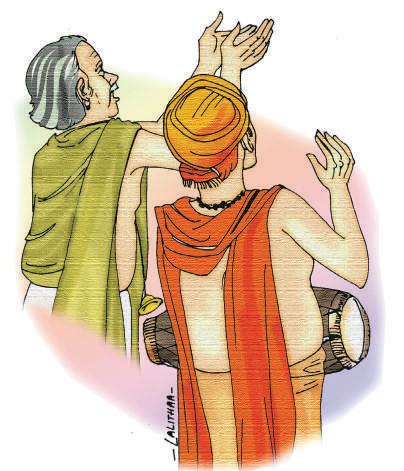
37 minute read
Editorial
Swachh Bharat Our Pride - Our Responsibility
Last month, India celebrated the success of Swachh Bharat Mission which is the world’s biggest movement for sanitation and cleanliness. The Mission or Abhiyan which began as a five-year project in 2014, had the goal of achieving a Clean India by the 150 th birth anniversary of Mahatma Gandhi on 2 Oct 2019. It became a people’s movement and created cleanliness awareness all over the country. By building over 11 crore toilets across rural and urban areas, the Abhiyan saved over 750 million Indians from the fate of open defecation. This single achievement along with waste management and personal hygiene awareness has saved millions of lives from communicable diseases, and brought financial and economic benefits to millions of poor people.
Advertisement
The first positive duty that Yoga prescribes as a preparation for a meaningful, spiritual life is Shaucha or cleanliness of mind, speech and body. And indeed, Indians are one of the cleanest races in the matter of personal hygiene – we bath at least once a day and our homes are quiet clean. But then why did we end up – as a foreigner described us – as ‘a very clean people living in a very dirty place’? Our public or common places are dangerously dirty and for centuries have caused millions of deaths through epidemics.
But we know also of the high standards of cleanliness and sanitation that was present even from the times of the Indus Valley Civilisation. Somewhere down the time this aspect of social life was lost and we became, as Gandhiji observed, a race who saw no virtue in national or social sanitation. Those with a keen understanding of history, trace this downfall as beginning from the time foreign invasions disrupted our social structure.
Hence, in our struggle to regain our national identity, leaders like Swami Vivekananda and Mahatma Gandhi laid great stress on social morality. From the very beginning of the Ramakrishna Math, Swami Vivekananda insisted that the sannyasis give importance to social cleanliness and orderliness. Once, very early in the morning someone was found to be cleaning the common toilet in Belur Math. It was uncleaned for many days. When curious sadhus went to see who it was, they were shocked to find Swamiji vigorously scrubbing and cleaning the whole place. He rejected their wailing request to desist and allow them to do the job. After a thorough cleaning, he came out and reminded the sadhus of the importance of keeping their surroundings clean. There is a symbiotic relationship between us and the external nature.
Swamiji’s concern for social morality developed a greater dimension when plague broke out in Kolkata in 1899. As the terrorstricken public fled the city in thousands, Swamiji who was recovering his health in the hills rushed back to Kolkata. Under the leadership of his disciples Swami Sadananda and Sister Nivedita he initiated the fight against the epidemic on 31 March 1899. He drafted a Plague Manifesto in which among other things he advised people to ‘Always keep the house and its premises, the rooms, clothes, bed, drain, etc., clean.’ He arranged a public meeting where university students and professors were gathered. He wanted the
students of Calcutta to volunteer and clean up with their own hands the Bagh Bazar locality which was most affected by plague. He knew that nation-building depended on man-making. And a campaign against unsanitary condition was a definite step in building such a character.
Addressing the students, Sister Nivedita described to them the unsanitary condition of a bustee and the reasons for it as she understood: ‘Everywhere we found all kinds of refuse thrown in front of the clean door-sills, and more frequently than not the passage between two houses was the common dust-bin. … No one who has noted the cleanliness of a Hindu hut inside will take it that the dirt outside is wilfully produced. … I attribute the bad habit of throwing refuse on the roads, or into out of the way corners, to the zenana system, which prevents women realizing the state of their surroundings.’ So, it was her conviction that if women recognised the importance of public cleanliness, and did all in their power to promote it in their own immediate neigbourhood, the streets and lanes of the city would become clean.
Nivedita gave the students a new conception of civic life. She told them, ‘A sweeper who accomplishes his work through an ideal is ready for an even greater ideal. What will that ideal be? It is for you to find out. By saving Bagh Bazar, we are writing the history of India with life itself; this history has never been written. This is our Ramayana.’
Nivedita, some sadhus, devotees, a handful of students, and a dozen paid scavengers waged a successful war against the plague. It was perhaps the first time a n o n - g ove r n m e n t o rga n i s a t i o n h a d approached the task in a systematic way creating a model for others to follow.
Some years later, Gandhiji gave a national focus to the task of social cleanliness and hygiene. A few days before the Congress Session of 1921, he asked the participants to prove their fitness for Swaraj by accomplishing, among other things, a sense of national or social sanitation. He wrote: ‘Perfect cleanliness must meet the eye everywhere despite accumulation of waste water, refuse and night-soil. … Khadinagar ought to provide an object-lesson in cleanliness.’
Today, Ramakrishna Mission has once again presented a small modern model for public participation in social cleanliness. It is in the Swachh Mangaluru Abhiyan conducted by Ramakrishna Mission, Mangaluru, Karnataka which we have here as this issue’s Cover Story.
In his comparison of the East and the West, Swamiji writes: ‘The grace of both Lakshmi and Sarasvati now shines on the peoples of the Western countries. They do not stop at the mere acquisition of the objects of enjoyment, but in all their actions they seek for a sort of beauty and grace. In eating and drinking, in their homes and surroundings, in everything, they want to see an all-round elegance. We also had that trait once — when there was wealth and prosperity in the land.’ Historians and sociologists agree that there is a close connection between social cleanliness and social prosperity.
In the Swachh Bharat Abhiyan, our country has spent more than 20,000 crores of rupees. Our society is awakening and the positive changes are there to see. To sustain these developments each one of us has to stand up and take the challenge of following safe and clean disposal of waste, and keep our immediate neighbourhood clean. Let us be responsible.
Swachh Mangaluru Abhiyan for Swachh Bharath
A Journey from a Campaign to a Revolution!
SWAMI EKAGAMYANANDA
Five years ago the Government of India requested Ramakrishna Mission to actively participate in the Swachh Bharath Abhiyan. The call was to conduct cleanliness campaigns every week for five years from 2 Oct 2014. The goal was to achieve a clean India as a tribute to Mahatma Gandhi on his 150 th birth anniversary in 2019. Ramakrishna Math and Mission, Mangaluru answered this call in a manner that transformed the campaign into a revolution! The story of this adventure is presented here in the words of Swami Ekagamyananda who led the movement.
Towards the end of September 2014, our headquarters at Belur Math instructed us to take up the Swachh Bharath Abhiyan and inspire our devotees and the people of Mangaluru to participate in the cleanliness drive. Initially I was not enthusiastic about getting involved in this Abhiyan. I saw it as a Central Government project and also thought that given the huge fan following of the Prime Minister our service would not be required for the success of the campaign. Furthermore, I felt that our time and energy could be better utilised in more essential fields of service.
Ramakrishna Mission has always worked in areas that are usually neglected by others. We step in only when a real need is perceived and then tirelessly work for its fulfillment. Here we can refer to two such projects successfully undertaken by the Mangaluru ashrama. One is the Balakashram, a hostel run in the Math premises for meritorious high school boys hailing from poor families in and around the Malnad region of Karnataka. Malnad which is situated on the slopes of the Western Ghats is a tough terrain of hills, rivers, streams, and waterfalls and the interior villages do not have high schools in walking distance. Most of the students, even meritorious ones, drop out of school after primary education. Selected students from this category are admitted to our Balakashram.
The second project was born of a survey conducted in the local area. When we visited the local schools we came to know the plight of students coming from the lowest economic rung of the society—children of labourers and slum dwellers. They came to school hungry, illclad and dirty and they were also poor in studies because there was no one to guide them. To serve these unfortunate children, we started in our Math the ‘Vivekananda Coaching Center’. Every evening nearly 150 students from class 4 to 10, receive tuition classes for two hours. After the class, they are given nutritious food and milk. Every year they are given
The author is a sannyasi of the Ramakrishna Order serving at our Mangaluru centre. The write-up is prepared by Smt. Shobha Alva, a devotee of the Math. mangaluru@rkmm.org f swacchmangaluru
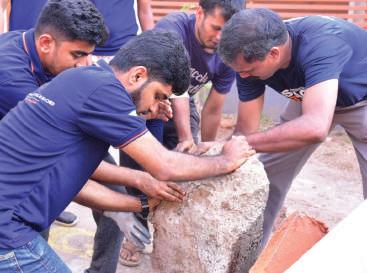

5 years: 2015 – 2019 2500+ Programmes 250 Groups 200 Weeks (Sundays) 10,000 Proud Volunteers 20 Lakh Man-hours 13000 Swachhata Senanis in 130 schools 2000+ News Articles

uniform, books, school bags, and umbrellas. Routine health checkups are conducted. They are provided with soap, toothbrush, toothpaste, hair oil etc., and encouraged to be clean and tidy. Also every Sunday they received cultural and spiritual training. All these services are provided free of cost.
Swachh Bharath Abhiyan began on a grand scale at Rajghat, New Delhi on 2 Oct 2014 with the slogan ‘One step towards cleanliness’. The Prime Minister Sri Narendra Modi had earnestly requested our country men and women to dedicate at least 2 hours per week— around 100 hours in a year—for this Abhiyan. I imagined that millions of government officials and enthusiastic students would participate and this Abhiyan would be a giant leap in the progress of our country. But I was wrong! By the end of the month everything was back to square one. At many places, the Abhiyan was limited only to exhibition of banners. A few people took brooms in their hands and posed for photos and publicity and people continued dumping garbage on roadsides!
This prompted us to earnestly take up this project in Mangaluru and strive to create a rolemodel Swachh Bharath Abhiyan. We worked Srimat Swami Gautamanandaji & Dr. Harsha,
Commissioner of Police, Mangaluru 12 The Vedanta Kesari November 2019
The young and the energetic
hard for two months and prepared a plan to make this campaign a success. The major task was to present to the Mangloreans the concept of a Clean India. The first step we decided would be to clean the city and remove the garbage heaped in almost every street corner. For this we needed a workforce of dedicated volunteers. We contacted devotees, schools and colleges and the general public of Mangaluru. Wherever I went, I was welcomed with the words, ‘No Swamiji, it will not work. It is an impossible task.’ They said such a campaign would never succeed in Mangaluru because most of the people here work in schools, colleges and offices. And who would volunteer to pick stinking garbage from roadside! ‘Nobody will come for shramadan at 7 AM on Sunday mornings’ they discouraged me.
But I didn’t lose hope. ‘Come what may, we will take up the project at least for a year as an experiment, if nobody comes I will sweep the roads alone’, was my thought. We launched the ‘Swachh Mangaluru for Swachh Bharath’ Abhiyan on 30 January 2015, which is the Martyr’s Day. Our programme began with a rally of 2000 students, oath taking ceremony
and honoring of 100 Poura karmikas or Corporation workers.
We did not know from where we would get financial aid for the huge task before us. But I had faith in words of Swami Vivekananda who said that when we selflessly work for a noble cause, financial help will somehow come of its own. This proved to be true very soon. In one of our Swachhata Andolan programmes, the chief guest was Sri Dharmendra Pradhan, the Union Minister for Petroleum and Natural gas. Another important guest on the stage was Sri H. Kumar, the M.D. of Mangalore Refineryand Petrochemicals Limited (MRPL), Mangalore, a Central Public Sector Enterprise. Fortunately for us, the Union Minister requested Sri. H. Kumar to financially support our project and the latter immediately agreed. From then on M.R.P.L. became the major sponsor of this 5-year project! NITTE University and individuals also contributed their mite. The total expenditure of the Abhiyan was around 7 crores.
Though some volunteers began with great enthusiasm they gradually dropped off from the Abhiyan. To overcome this, I adopted a new approach. I first prepared a list of nearly 200 individuals who were close to the Math and then every Saturday for over two hours I sat with my mobile and rang up each one of them personally requesting them to assist us in the next day’s shramadan. The strategy worked. Every Sunday nearly a hundred dedicated volunteers would show up at the shramadan site with brooms in their hands!
We divided the Abhiyan into five phases. The first phase was in 2015, the second in 2016, the third phase in 2016 - 2017, the fourth phase was in 2017 - 2018, and the fifth in 2018 - 2019. In the first and the second phase, we worked as a single team and cleaned up different areas of our city. By the time we reached the third phase, the news of our work had spread across the city. And 50 teams of volunteers joined us out of their own will. We took up cleanliness drive in 10 - 15 places every week and completed five hundred shramadan projects in Mangaluru.
Many people think that shramadan is nothing more than sweeping the city. But we had a different idea. We repaired footpaths and roads; we painted fly-overs and beautified them with artwork; we renovated old bus shelters replacing broken seats with new ones, and even built new bus shelters when requested by local people; we removed unofficial banners and posters from public walls and painted the walls with artwork; we erected more than 150 signposts; we constructed auto shelters; we put up barricade railings on roads for the smooth flow of traffic; we cleaned public toilets, we cleaned roadside garbage dumping places; and we constructed new parks wherever possible.
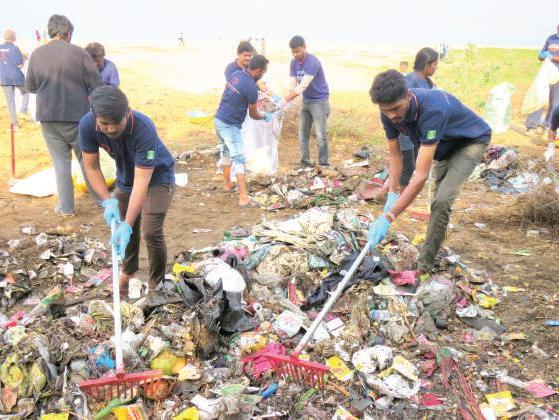


before Abhiyan
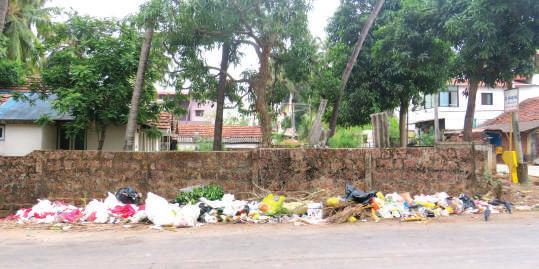
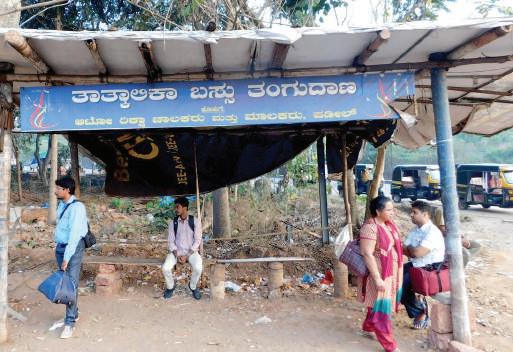
People have sometimes asked, ‘Do the places that you clean up, remain clean?’
In the beginning this was a real challenge for us. After we cleaned a place, the very next day people would again dump garbage at the same spot. Banners with requests and warnings did not help. People did not care even when we told them that there were close circuit cameras. They kept dumping garbage because they knew there were no cameras. Notices were put up that people who dumped garbage on roadsides would be fined; but nobody cared.
At the very beginning of the Abhiyan, we identified more than 900 black spots in the city. These were places where people had been dumping garbage for a long time. Reducing these black spots by changing people’s behaviour was the challenge. Finally, we came up with a simple plan. We decided to remove the banners we had put up at these black spots warning people not to dump garbage. Strange but true, these boards seemed to guide people to the exact spot to dump their garbage!
To everybody’s surprise our plan worked! People stopped throwing garbage in such black spots. And moreover, after cleaning up we before Abhiyan after Abhiyan
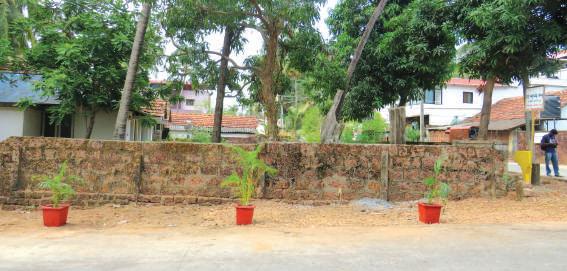
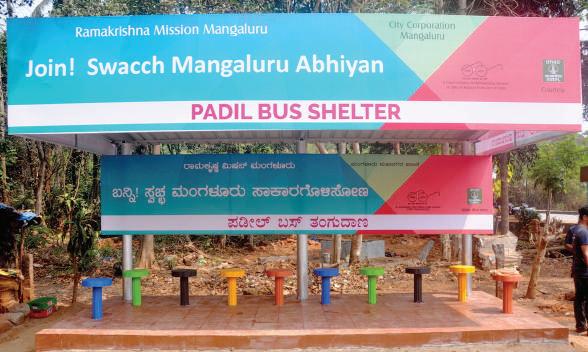
decorated the places with flowerpots and beautiful plants. Slowly people started cooperating. At the same time a special team of 85 volunteers kept watch (often the whole night) over the cleaned black spots. They called themselves warriors of cleanliness! When people threw garbage, these volunteers would pick it up and deliver it back to their owners with the gentle request that they give it to the garbage collecting vans! Hard work reduced the black spots from 900 to just 40. Today, many roads of Mangaluru are garbage-free.
In the fourth phase we had four different kinds of programmes. There were the weekly shramadans on every Sunday. The second programme was ‘Swachh Manas Abhiyan’ or ‘Campaign for Clean Mind’ organized for school children. The third was ‘Swachh Gram Abhiyan’ or ‘Clean Village Campaign’ organized for one hundred villages of Dakshina Kannada. The fourth was ‘Swachh Soch’ or ‘Clean Thoughts’ campaign for college students. 50 teams of our volunteers visited various residential layouts everyday and conducted 200 awareness programmes in 200 days. (Continued on page 21...) after Abhiyan
Reminiscences of Sargachhi
SWAMI SUHITANANDA
Swami Premeshananda (1884 – 1967) was a disciple of Holy Mother Sri Sarada Devi. For over two decades he lived at Ramakrishna Mission Ashrama, Sargachhi, West Bengal. Under his inspiration countless people led a life of spirituality and service, and many young men and women entered into monastic life. His conversations – translated from Bengali and presented below – were noted by his attendant who is now Swami Suhitananda, one of the Vice-Presidents of the Ramakrishna Order.
44
(Continued from previous issue. . .)
3.11.60 (continued …) M aharaj: You cannot spend the whole day in meditation and japa. Without compromising on them, you have to devote the rest of your energy to work. In this way you can do your work, Swamiji’s work, and work for the good of the world. You cannot live without working, so do work that will benefit others.
A revolutionary once fled to Uttarkashi and became a sadhu. But he couldn’t do meditation or japa. The bank of the Ganga, where the sadhus lived, was getting eroded by the current of the river. So he carried boulders every day and built an embankment there. There was another sadhu in the rural area of Mymensingh who was known as ‘Kodaley Baba’ (sadhu with a spade). He used to stay in a village for two years, grow a garden there, and then move on to another village. every action of this body-mind-intellect—he is totally detached, just like Mathuradas and Trailanga Swami. The cases of Sri Ramakrishna and Holy Mother Sri Sarada Devi are different —they had to force their minds down to a lower plane. Totapuri also remained in an exceptional state. He went beyond the stage where Brahman is perceived in all living and non-living beings of the world—sarvam khalvidam Brahma. Sri Ramakrishna brought him down to this perception
Question: If we pray to God, will the bondage of our body and mind be gradually cut asunder?
Maharaj: It is not possible to answer this question in a word. While meditating, focus on the heart (the psychic centre at the heart), not on the forehead. If the mind does not settle in the heart, imagine that your Chosen Ideal is sitting on a throne in front of you.
17.11.60
Question: How does a jnani (a man of knowledge) work?
Maharaj: After the attainment of knowledge the jnani becomes the witness of
18.11. 60
Maharaj: The wave of the sea merges in the sea. I do not want to become sugar, I want to enjoy the taste of sugar. These are Sri Ramakrishna’s words. These words scare us.

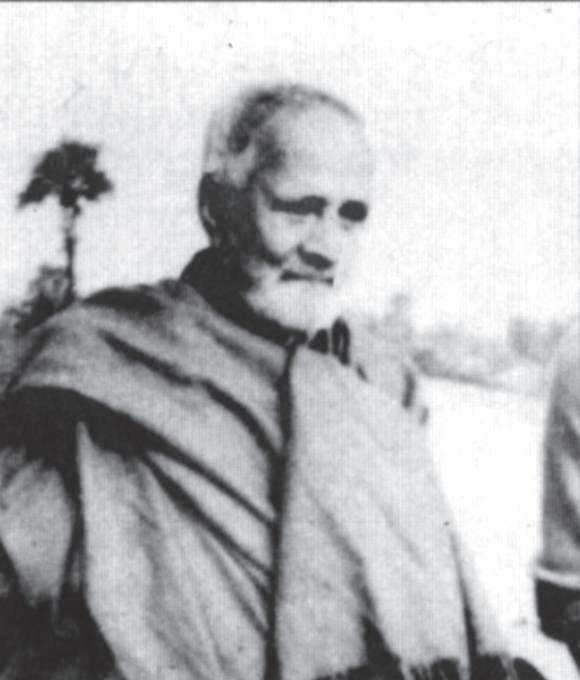
This prostrating at the feet of the Lord, weeping continuously, etc., weakens us. Rather, if we know that we are That, but have come down to this sorry state, and by ascending continuously will again be in that nirguna (attributeless) state – then we will have confidence and will also feel that we have a claim on Him. We will develop devotion and be able to pray to Saguna Brahman or God with attributes.
Listen very carefully so that you do not commit the slightest mistake. First there is the body-mind-intellect; then there is the k a r a n a anandamaya kosha or the causal blissful sheath; beyond that maha-karana; and lastly N i r g u n a Brahman. Creation does not evolve out of Nirguna Brahman, it evolves from Saguna Brahman. S r i Ramakrishna is Nirguna Brahman and Holy Mother Sri Sarada Devi is Saguna Brahman. Holy Mother is a wave in the nirguna ocean and we are wavelets. She showed us the way and then merged into the ocean. What is this way? It is the way to reach the nirguna. We are kshara, perishable, Holy Mother is akshara, imperishable, and Sri Ramakrishna is Purushottama,the Supreme Being. (reference is to Bhagavad Gita 15:18)
Question: Can we come out of tamas? Unless we reach sattva, how can we find the way out?
Maharaj: Oh dear! It is the way to progress that we are discussing! You cannot move ahead if you stay put under the excuse of being in tamas. That’s why I say that you acknowledge tamas and go forward. As you proceed, tamas will diminish and gradually sattva will appear.
It is not possible to lead the life of a sannyasin as an individual. That is why we have the Order, w h e r e e v e r y o n e i s nourished by mutual cooperation. Our Order has not yet fully blossomed. But we are still only in our second generation—we are right after
Sri Ramakrishna’s direct disciples.
After us, it will be your turn and you will create a favourable environment. Thereafter many will be born yogis. By then people will have progressed in society, and society also will be better. (To be continued. . .) Swami Premeshananda
‘Failures are the pillars of success!’ Knowledge arises through the combination of all our mistakes and errors, our good and bad deeds. … How many thousands and thousands of times you have assumed various bodies, how many good and bad deeds you have performed! You have forgotten all this and, by calculating the insignificant merits and demerits of this one little life, are suffering for no reason. Look at the numberless past lives you have lived; think about your limitless future lives. … You do not belong to your father or mother, to any caste or any person, to any country or any time—you are chaitanya, pure consciousness, beyond time, space, and causation. Don’t worry or have regrets for no reason. —Letters of Swami Premeshananda. 1: 95
RAMAKRISHNA MATH (KATHAMRITA BHAVAN) 14, Guruprasad Choudhury Lane, Kolkata - 700 006 Mobile: 89025-53411 / 7980391808 E-mail: kathamrita.bhavan@rkmm.org
An Appeal for Expansion of Service Activities
Kathamrita Bhavan was the residence of Sri Mahendra Nath Gupta (M.), a householder devotee of Sri Ramakrishna and the chronicler of Sri Sri Ramakrishna Kathamritha (translated as The Gospel of Sri Ramakrishna). This house is now a branch centre of the Ramakrishna Order and is known as Ramakrishna Math – Kathamrita Bhavan.
The house is sanctified by the visits of Sri Ramakrishna, Holy Mother Sri Sarada Devi, Swami Vivekananda, and other direct-disciples of Sri Ramakrishna. Moreover, Holy Mother stayed here on several occassions and many sannyasis of the Ramakrishna Order were groomed by M. in this very building. It is today a place of pilgrimage for thousands of devotees. But this historical house is a small building. So, to accommodate the centre’s expanding service activities, and also keeping in mind its future needs, we are trying to purchase some neighbouring buildings.
By Sri Ramakrishna’s grace, some adjacent houses have come forward to sell their properties to the Math. We have to urgently take up these offers for which we need a sum of Rs. 1,00,00,000/- (Rupees One Crore).
We humbly request the admirers and devotees to donate liberally and help us to raise this amount.
May the blessings of the Holy Trinity be bestowed upon all is our ardent prayer. All donations are exempt from Income Tax under section 80G.
Please send your donations by Cheque/DD/RTGS/NEFT in the name of Ramakrishna Math, Kathamrita Bhavan.
Along with your donation please also send a covering letter stating the purpose of the donation, your PAN number, your full postal address, phone number and Email. Bank : State Bank of India Branch : Srimani Market A/C Name : Ramakrishna Math, Kathamrita Bhavan A/c No. : 37162044100 IFSC Code : SBIN0031539 With prayers for all, Yours in the Service of the Lord
Swami Siddheshananda Adhyaksha
An Appeal SRI RAMAKRISHNA MATH, THANJAVUR A NEW SUB-CENTRE OF SRI RAMAKRISHNA MATH, CHENNAI
Dear Devotees,
Ramakrishna Math & Ramakrishna Mission centres across the world motivate people to come together & serve humanity as a form of worship in the fields of Health Care, Education & Spirituality.
Ramakrishna Vivekananda Educational Trust run by the devotees of Bhagawan Sri Ramakrishna at Mariyamman Kovil (near Thanjavur) is rendering service in the rural areas of Thanjavur District for the past 26 years. This trust is now taken over by the Ramakrishna Math & Ramakrishna Mission, Belur, Kolkata & is functioning as a sub-centre of Sri Ramakrishna Math, Chennai from July 2019.
To expand the service activities, a new Math of this sub-centre is being started in Thanjavur town. We seek your generous contribution for these activities:
1. Getting land for the Ashrama Rs.80 lakh 2. Establishing the Ashrama with a new Temple Rs. 3 crore 3. Nitya Pooja of Sri Ramakrishna Rs. 50 lakh 4. Renovation of the existing Temple 5. Rural development projects 6. Endowment for Sadhu Seva Rs. 20 lakh Rs. 1 crore Rs. 50 lakh
AN APPEAL TO DEVOTEES AND WELL-WISHERS Dear Friends, Namaste. We pray for you and your family.
Sri Ramakrishna Math, Chennai has been rendering service for over 120 years to the society in the fields of Health, Education, Publication of Spiritual & Inspirational books and magazines both in English & Tamil, cultural activities, relief work etc. In order to execute the projects on hand, we appeal to you for contribution.
Service activities in brief Maintenance of Vivekananda Centenary Girls Hr. Sec. School for under privileged (900 students) Maintenance of Sri Ramakrishna Math National School for under privileged children (350 students)
Rehabilitation Service to Leprosy afflicted persons – 120 beneficiaries
Medical Service to 600 - 800 poor patients daily
Nursing Assistants Training for poor rural girls – 30 students per batch of 1 year Rural development – Education, Women Welfare & Medical Help, Alcohol de-addiction – 100 beneficiaries Sri Ramakrishna Daily puja, Neivedyam and Arathi Daily Annadhanam for 200 devotees Sadhu Seva per day for 50 members
Expenses Monthly Rs.7,20,000/-
Per student Rs.800/- Monthly Rs.2,80,000/-
Per student Rs.800/-
Monthly Rs.1,20,000/- Per beneficiary Rs.1000/-
Monthly Rs.5,40,000/-
Per patient Rs.900/-
Per batch Rs.7,50,000/-
Monthly Rs.1,00,000/- Per beneficiary Rs.1000/-
Your support needed Rs.8000/- For 10 Students Rs.8000/- For 10 students
Rs.10,000/- For 10 beneficiaries
Rs.9,000/- For 10 patients
Rs.25,000/- Per student
Rs.5000/- For 5 people Rs.10,000/- Per day Rs.10,000/-
Rs.5,000/-
Donations for both Thanjavur & Chennai Math may please be sent by cheque / DD favouring “Sri Ramakrishna Math”. For Online donation please visit https://donations.chennaimath.org Transfer directly & intimate us along with PAN details through email. Donations are exempted from Income Tax under Section 80G.
May the blessings of Bhagavan Sri Ramakrishna be on you is my earnest prayer to Him.
Sri Ramakrishna Math 31, Sri Ramakrishna Math Road, Mylapore, Chennai-4. & : 24621110. email : mail@chennaimath.org website : www.chennaimath.org For more details : 98409 87307 Yours in the Service of the Humanity, Swami Gautamananda Adhyaksha
Ramakrishna Mission, Shillong Ramakrishna Mission Road, Laitumkhrah, Shillong, Meghalaya 793 003, India Phone : 0364-2221709 & 2536767 Email : shillong@rkmm.org
An Appeal
For the Renovation of the Historical Quinton Hall
Not all the cities have the privilege to hear a Prophet, let alone hear his parting words in the last public lecture! Shillong was indeed blessed to hear Swami Vivekananda for the last time in a public lecture on 27 th April 1901 at the Quinton Hall. For a long time the Quinton Memorial Hall witnessed the evolution of the institute and the city as well. Apart from Swami Vivekananda, many eminent personalities including Swami Abhedananda, Rabindranath Tagore, Annie Besant, Acharya Prafulla Chandra Roy, Netaji Subhash Chandra Bose, Dr B.C. Roy and many others graced the hall with their illumined presence and eloquence. And with a tryst with destiny, the Hall remained in a state of shambles for years, after it went to the custody of a business house, kept as a Cinema Hall for decades. But the phoenix rose again from the ashes and has taken the shape of the Ramakrishna Mission Vivekananda Cultural Centre, catering to the needs of 6000 students annually in different fields. The Hall presently needs urgent renovation, as it has not undergone any major repairing work for almost two decades and is in constant demand for various purposes of the Institute. A sum of Rs. 1.2 crores is estimated for repairing, renovating and enhancing the facilities of the historical Hall. We request devotees and admires to donate generously for this noble. Donation may be sent by means of Cheque/DD in favour of “Ramakrishna Mission, Shillong” or NEFT/RTGS. All donations will be duly acknowledged. Our bank details are:
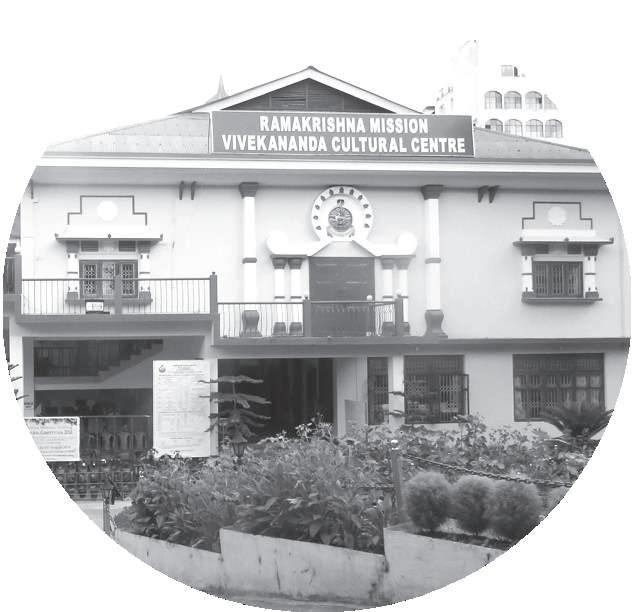

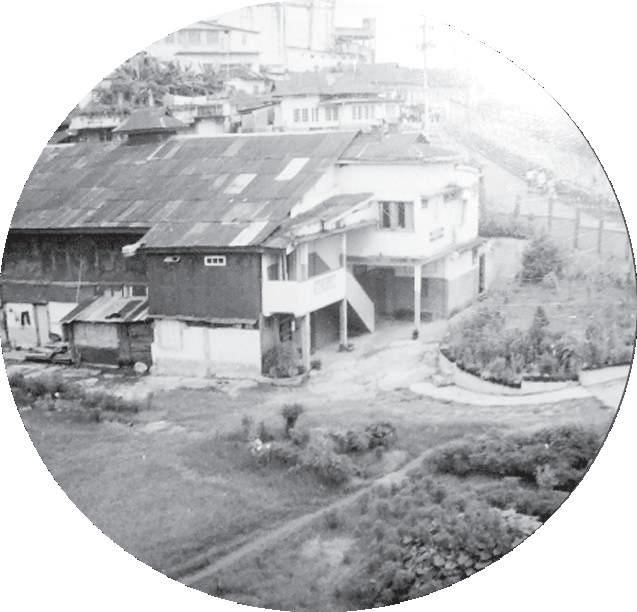
Bank Name : State Bank of India A/c. Name : Ramakrishna Mission, Shillong Bank Account No. : 10613596070 IFSC No. : SBIN0002081 Bank Address : Laimukhrah, Shillong PAN No. : AAAAR1077P Please mention the purpose of donation – ‘Renovation of the Quinton Memorial Hall’, The PAN and full address through email at shilling.vcc@rkmm.org May Swami Vivekananda bless you all! Swami Sarvabhutananda (Secretary)
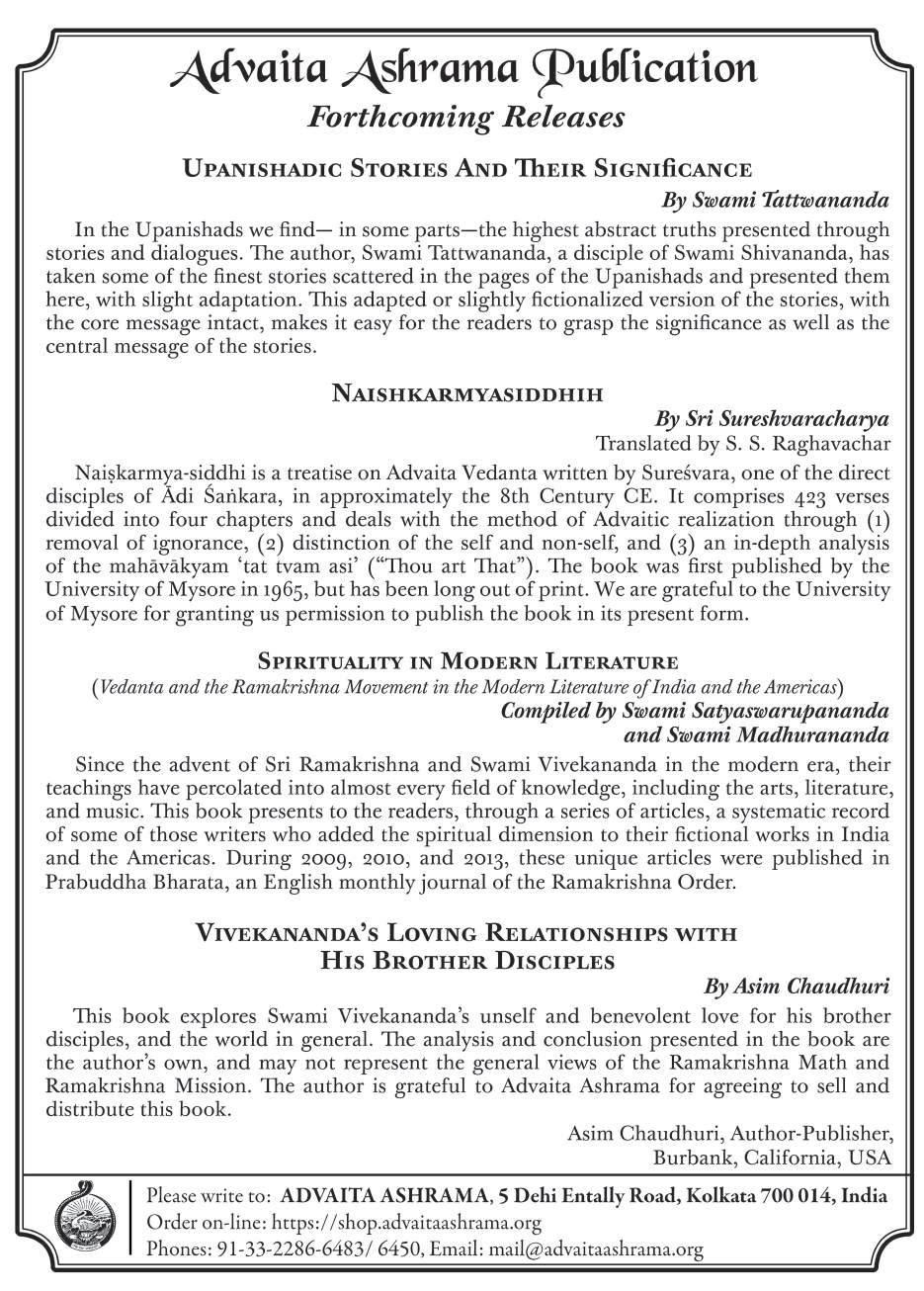
(Continued from page 14...) Swachh Mangaluru Abhiyan for Swachh Bharath
We had five types of programmes in the fifth phase of Swachh Bharath Abhiyan. Along with the four programmes of the fourth phase, the fifth and the most innovative addition was ‘Swachhata Jagrithi Jana Sampark Abhiyan’ or ‘Mass Contact Campaign for Cleanliness Awareness’.
At this phase Swami Jitakamananda, head of the Mangaluru centre wanted to involve school children in the Swachhata Abhiyan. A nation is built when its children are educated. To create awareness of cleanliness among school children, over 500 ‘Swachh Manas’ programmes were organized in 130 city schools. 100 students from each school, adding up to 13,000 students were specially trained in cleanliness and recognised as Swachhata Senanis or Soldiers of Cleanliness. Innovative projects like the Swachhata Chintan (Clean Thoughts), Swachhata Divas (Cleanliness Day), Swachhata Darshan (Clean Perception) and Swachhata Manthan (Clean Discussion) were organized in these selected schools. 70 resource persons visited these schools to train the children.
To create awareness among the college students, ‘Swachh Soch’ programmes were arranged in the city’s colleges. Symposiums were organized in about 50 colleges of Dakshina Kannada and Udupi districts. Lectures, demonstrations, workshops and debates were conducted by our resource persons. District level and state level seminars were also organized for college and university students.
More than 2000 cleanliness drive programmes were organized in 100 villages of the Dakshina Kannada district and 100 villages of Udupi district under Swachh Gram Abhiyan or Clean Village Campaign. 100 volunteers from every village were nominated as the members of the Abhiyan. Over 8000 members took up shramadan projects on one Sunday of every month in their respective villages.
During the year 2017-18, fifty teams of our volunteers visited nearly 20,000 houses in Mangaluru city to create awareness among people under Swachhata Jagrithi Abhiyan. 200 programmes were organized in 200 days under this project.
Swachhata Jana Samparka Abhiyan events were organized every day at different residential layouts of the city. During each event, our volunteers organized awareness programmes with the slogan ‘Our Garbage, Our Responsibility’. They conducted demonstrations to educate people on how to prepare organic manure at home using earthen compost pots. ‘Swachh Bharat’ pamphlets were distributed to create awareness. 220 such events were conducted throughout the year.
Volunteers and experts explained to people the concept of decentralized waste management through proper ways of disposal.
Japanese volunteers
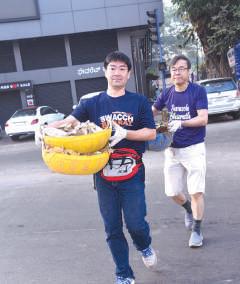

A people’s movement

Transgenders in the Abhiyan
Swami Jitakamananda—the guiding force

There are two kinds of domestic waste, the wet waste and the dry waste. The organic wet waste produced in kitchens is composed of vegetable and fruit peels and the leftover food. It’s a known fact that such waste produces foul smell if not disposed of within a day. If the garbage collectors don’t come in time, people tend to throw it on the streets. Pot composting is the solution for this problem. We introduced the concept of pot composting for wet waste management in Mangaluru by providing households at subsidised rate earthen compost pots (each unit consisting of three pots placed one above the other) and a bag of coco fiber.
The wet waste from the kitchen is collected in the topmost of the three pots and a thin layer of coconut fiber is spread on the top every night. For a family of four to five members, it may take twenty to thirty days for the pot to be filled. Even non-vegetarian food waste can be collected in the pot. When the first pot is full, it is placed in the middle and the second pot is placed on the top. By the time the
Swachh Manas programme for 13000 school children
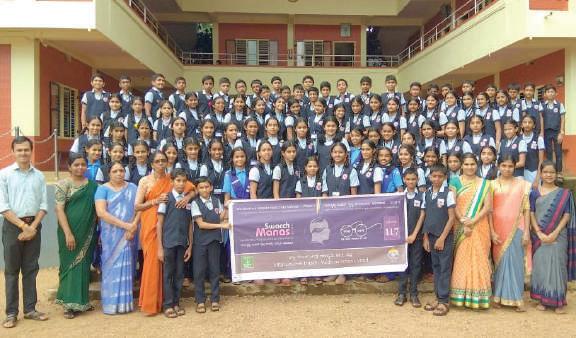
240 Magic shows
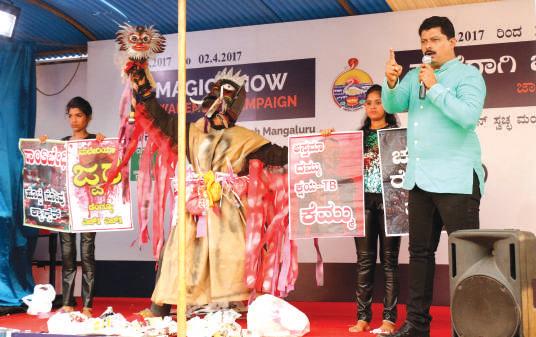
second pot gets filled, the natural manure of very fine quality will be ready for use in the bottom pot. Mangalore Chemicals and Fertilizers Limited (MCF) has certified the fine quality of the manure produced in this manner. This natural manure is produced by small worms that breed in the pots and these tiny worms are not at all harmful. This manure can be used for gardening or sold for a profit.
The concept of pot composting is spreading in Mangaluru city. 1000 homes in Mangaluru already have these pots and more than 4000 people have placed orders for these compost pots which we procure from Mysuru and other places. What a wonderful way to dispose garbage! We are sure that this movement will end the practice of dumping city garbage in hundreds of acres of land outside the city and thus stop land, water and air pollution.
Generally, we have to pay for the disposal of dry waste that we generate. But we have designed a project where people can earn from
Dumpyard converted into Arise! Awake! Park

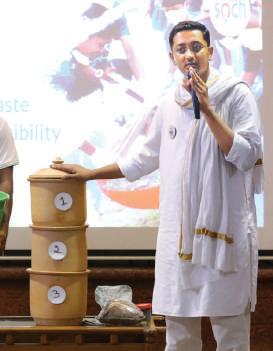
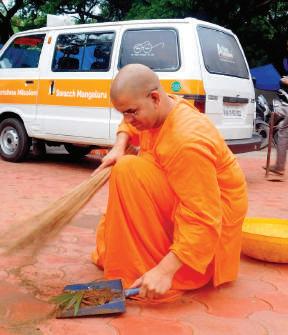
their dry waste! The plan is to visit residences that use compost pots and collect their dry waste. This dry waste will then be sent for recycling and the income thus generated distributed among the people who generated waste.
Magic shows for cleanliness was another innovative way of t e a c h i n g p e o p l e a b o u t cleanliness. We organized 240 magic shows by Sri Kudroli Ganesh, a famous magician, at various schools and other venues in the city. 1,30,000 students and general public were educated in this manner.
Throughout the five years the media was a constant source of encouragement. There was regular, extensive coverage in newspapers, magazines, and television and more than 2000 articles were published about Swachh Mangaluru Abhiyan.
All the Swachh Mangaluru Abhiyan programmes witnessed enthusiastic participation by people from all walks of life. There were government officers, teachers, college students, and school children; and there were eminent personalities like Sri. Venkaiah Naidu, Hon’ble Vice President of India, Bollywood actor Sri. Nana Patekar, Dr. B.R. Shetty of Abu Dhabi, Padma Bhushan Dr. B.M. Hegde, Nitte Vinaya Hegde, Union Ministers Sri. Dharmendra Pradhan and Sri Ramesh Jigajinagi, MPs and MLAs. In the 5-year Abhiyan over 20 lakh hours of human resource were involved.
The Concluding Programme of the Swachh Mangaluru Abhiyan was held on 29 Sept 2019 at the Central Market of Mangaluru. Befitting the movement, it was organized as a massive shramadan in which more than 100 NGOs and groups of individuals joined hands with us to clean 23 black spots in the Market. Srimat Swami Gautamananda Ji, one of the Vice-Presidents of the Ramakrishna Order, graced the occasion along with other dignitaries.
In his benedictory address Gautamananda Ji praised the w h o l e t e a m o f m o n k s , volunteers, and citizens of Mangaluru for making the Swachhata Mission a phenomenal success. He said if Swami Vivekananda was physically present, he would have proudly praised all those involved declaring, ‘Sabhash! You have all become men of substance.’ Revered Gautamananda Ji said the Swachh Mangaluru Abhiyan was a successful model that could be replicated across India.
This has been a fairy tale transformation in the landscape of Mangaluru city, and more importantly in the mindset of Mangalurians. Senior citizens, elected representatives, and even government officials have requested us to continue our campaign in the coming years. We will do it. Within the next 10 to 15 years, our goal is to convert all the wet waste in our city into compost manure, and recycle all the dry waste.
O u r S w a c h h M a n g a l u r u volunteers have set a goal before themselves— To convert Mangaluru’s Pacchanadi (the 100 acre dumping yard) into Swachhanadu (Clean Region)! Pot composting Swami Ekagamyananda leading the Abhiyan
125 th Anniversary of Chicago Addresses : Concluding Programme
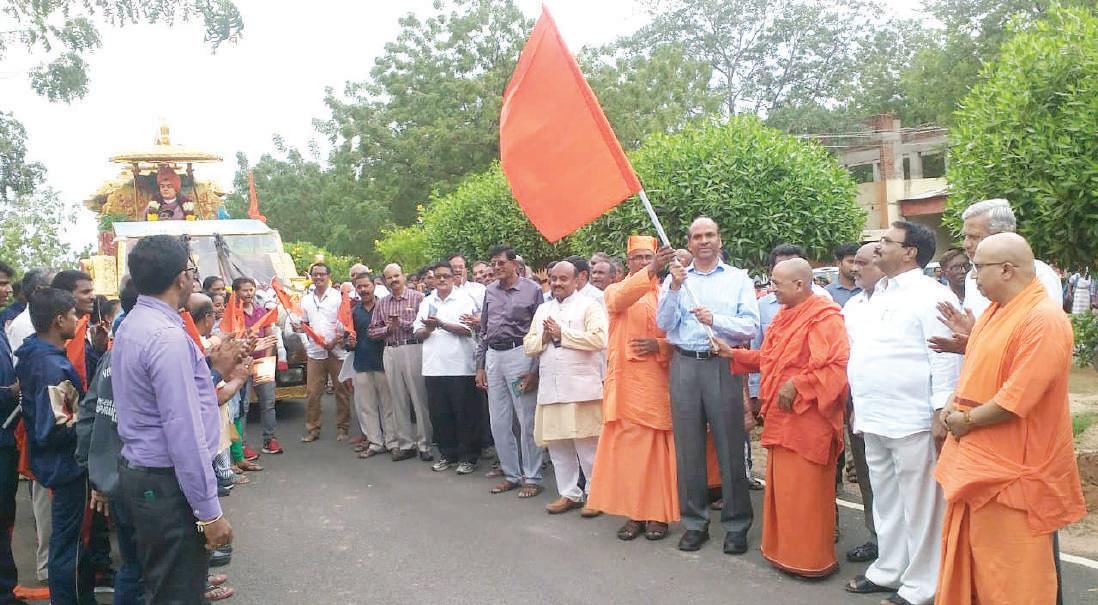
For the last 12 months the branch centres of the Ramakrishna Order the world over celebrated the 125 th Anniversary of Swami Vivekananda’s historic Addresses at the World’s Parliament of Religions in Chicago, USA. These celebrations strongly reawakened across India and in many other countries the memory of Swami Vivekananda’s historic addresses. Lakhs of students and general public were introduced to Swamiji’s Chicago lectures and through them to a deeper understanding of the fundamental tenets of Hinduism.
We have every month given brief reports of these events. This Special Report sums up some of the main activities and the concluding programmes of the celebration. The number of participants in each programme is given in brackets.
Programmes by the Head Quarters
The year-long celebration which was formally inaugurated at Belur Math, the Head Quarters of the Order on 11 Sept 2018 had a grand finale with various programmes organised by the Head Quarters and the branch centres. The Inaugural Meeting of the Concluding Programme at Belur Math, presided by Srimat Swami Shivamayananda Ji, one of the Vice-Presidents of the Order was held on 11 Sept 2019 (3500 devotees). Swami Suvirananda Ji, the General Secretary of the Order welcomed the gathering, Hon’ble Justice Pinaki Chandra Ghose, Chairperson, Lokpal delivered the Chief-Guest address and Srimat Swami Smaranananda Ji Maharaj, the President of the Order, gave his benediction.
The Head Quarters organised a day-long Devotees’ Convention at Belur Math on 12 th
Sept (5000); a Public Meeting on 19 th Sept (1500) and a Sanskrit Seminar on 21 st Sept (600 lecturers/students) at the Institute of Culture, Golpark; and a Youth Convention (2500) and Valedictory Meeting (1500 devotees) for the year-long programme at Nazrul Mancha, Kolkata on 27 th Sept. The Public Meeting was presided by Srimat Swami Gautamananda Ji, one of the Vice-Presidents of the Order and Justice Ashok Kumar Ganguly, Former Judge, Supreme Court of India and Justice Biswanath Somadder, Calcutta High Court addressed the meeting. Swami Tattwavidananda, one of the Asst. Gen. Secretaries of the Order, Dr. Samiran Chandra Chakrabarti, Former Professor, School of Vedic Studies, Rabindra Bharati University, Kolkata and a number scholars spoke in the Sanskrit
Shiva’s Demon
GITANJALI MURARI A fictional narrative based on incidents from the childhood of Swami Vivekananda.
‘O h children, give a poor man some coins…’
The scrawny beggar clutching his torn rags and trying to cover his body, looked piteously at Naren and his friends. Naren stopped playing and walked over to him.
The beggar cried again, ‘Give me some money so I can buy a shirt, little boy…’
‘Ma, I gave it to a poor man,’ he replied beaming with joy.
Unrepentant, Naren smiled more widely and shook his head.
‘That’s not fair ma,’ Naren yelled throwing all the cushions from a couch on the floor.
‘Put them back at once,’ she ordered, but he turned his face to the wall refusing to look at her. ‘You are a very disobedient boy! I prayed to Shiva for a son, just like himself…instead he sent me one of his demons...’ Leaving the room, she locked the door behind her.
Naren frowned. ‘Why does ma get angry every time I give something away? She also gives so much…then what is the difference between my giving and hers?’ The sound of music reached his ears and he looked out of the window eagerly. It was a small band of minstrels singing one of his favourite bhajans in praise of Rama and Sita. Clapping his hands to the beat, he sang along, the words sweetly tripping off his tongue. Hearing his voice, the minstrels stopped under the window and danced with graceful movements.

‘You sing very well,’ they said. ‘Thank you,’ Naren smiled back.
‘So do all of you…that was wonderful music…’ The singers laughed and bowed, charmed by his brightness.
Noticing other people giving them money, it occurred to Naren that he too should give something. But when he looked around the room, his face fell. It was empty, save for the couch and one old iron trunk.
Lifting the heavy lid with some effort, he rummaged inside the box and found the perfect gift.
‘Wait,’ he called out to the minstrels, running back to the window and tossing out beautiful silk sarees to them.
Naren became serious, but the next moment his face broke into a delightful smile. ‘Ma will not mind…she says we must always share our good fortune with others …’
Blessing him and his mother, the minstrels waved goodbye and Naren stayed by the window, the strains of another song wafting back to him on the cool evening air.
The lowest man is he whose hand draws in, in receiving; and he is the highest man whose hand goes out in giving. The hand was made to give always. —Swami Vivekananda
